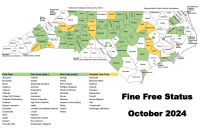The resurrection will arrive, sayeth the gardeners
There is a story about Katharine White — an editor and writer for The New Yorker magazine — that I enjoy recalling this time of year. This is good fodder for mulling over while you plant bulbs or move perennials. Both are timely tasks right now for our section of the world.
Katharine White, her husband, E.B. White, wrote, would pre-select a day each fall for planting the spring bulb garden. Bad weather didn’t matter.
“The hour had struck, the strategy of spring must be worked out according to plan,” he recalled in his introduction to “Onward and Upward in the Garden,” a book of his wife’s gardening articles he selected and edited.
Katharine White would dress in a raincoat, a little round wool hat, a pair of overshoes, and then go and sit at the edge of the plot in a folding canvas chair — a director’s chair. From this vantage point, she would direct her gardening helper on precisely where to plant new bulbs and basketfuls of old ones.
E.B. White recalled, “As the years went by and age overtook her, there was something comical yet touching in her bedraggled appearance on this awesome occasion — the small, hunched-over figure, her studied absorption in the implausible notion that there would be yet another spring, oblivious to the ending of her own days, which she knew perfectly well was near at hand, sitting there with her detailed chart under those dark skies in the dying October, calmly plotting the resurrection.”
I fully comprehend Katharine White’s passion for planting. It is easy to garden if working land you anticipate spending the rest of a lifetime, hopefully a long one, enjoying. But the true test comes with impermanence. When the gardener doesn’t know whether she’ll be there next spring, next year, in five years, or a decade.
Related Items
Fortunately, the madness for gardening usually overcomes doubts and wisdom. It is October, so we dutifully — even joyfully — plant bulbs, and the garlic that won’t be harvested till late next summer. Or we set out young perennial plants, knowing full well none will put on much of a show for several years.
Who will be there to enjoy them? The gardener, or perhaps someone else? No one? In the end, it doesn’t much matter. Writers write, painters paint, gardeners plant.
Henry Mitchell, hands down my favorite writer on the subject, wrote in one of his last columns for the Washington Post: “You wonder after many years if any of it was worth the bother. The answer is, I think, more or less yes. … Entire sections (of the garden) have to be rethought and old friends given up. All seems to be nothing but change and irregular advances and collapse, as if paying little attention to the gardener, who is seen to be far less consequential than we had supposed.”
Mitchell died shortly after he wrote these words, while helping a neighbor plant daffodils. I suspect Mitchell would have been touched and gratified by such a fitting demise, but also a bit amused by just how apropos his ending was. He is so good, I feel compelled to quote him at length on the subject of gardening faith. Or gardening madness, if you will:
“So there is no point dreading the next summer storm that, as I predict, will flatten everything. Nor is there any point dreading the winter, so soon to come, in which the temperature will drop to ten below zero and the ground freezes forty inches deep and we all say there never was such a winter since the beginning of the world. There have been such winters; there will be more.
“Now the gardener is the one who has seen everything ruined so many times that (even as the pain increases with each loss) he comprehends — truly knows — that where there was a garden once, it can be again, or where there never was, there yet can be a garden so that all who see it say, ‘Well, you have favorable conditions here. Everything grows for you.’ Everything grows for everybody. Everything dies for everybody, too.
“There are no green thumbs or black thumbs. There are only gardeners and non-gardeners. Gardeners are the ones who, ruin after ruin, get on with the high defiance of nature herself, creating, in the very face of her chaos and tornado, the bower of roses and the pride of irises. It sounds very well to garden a ‘natural way.’ You may see the natural way in any desert, any swamp, any leech-filled laurel hell. Defiance, on the other hand, is what makes gardeners.”
Winter looms, all is impermanent, we rent instead of own, the transportation department might build a road where our house is, the bank might foreclose, the river might rise, we could die tomorrow.
I say, what the hell — let’s all plant hundreds and hundreds of bulbs anyway.









